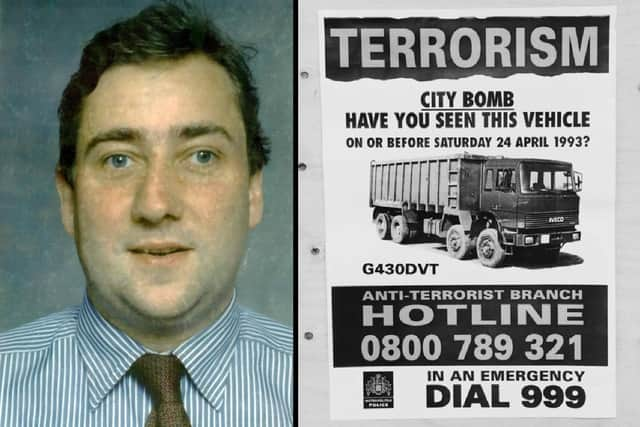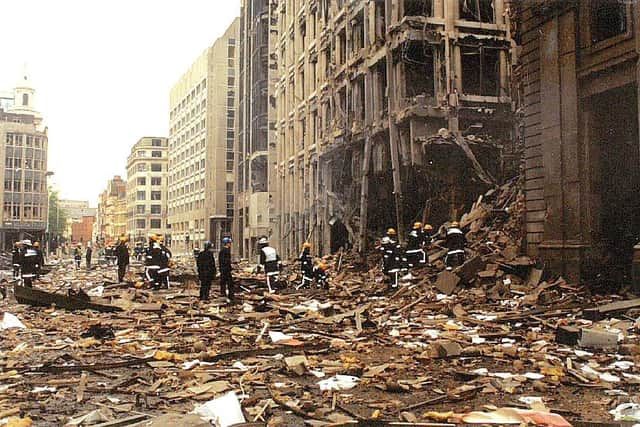Bishopsgate bomb 30 years on: UK newspaper boss recalls killing of 'friendly and generous' photographer Ed Henty in massive IRA blast amid city skyscrapers
and live on Freeview channel 276
Gary Jones, editor-in-chief of the Daily Express and Sunday Express, was aged 31 at the time of the blast which killed 34-year-old married father-of-two Edward Henty on April 24, 1993.
The pair worked closely together at the time, and Mr Jones says he still feels a sense of guilt over the incident and wonders if it would have played out differently if he had joined Mr Henty on his fatal assignment that day, when he was dispatched to get pictures of the bomb alert.
Advertisement
Hide AdAdvertisement
Hide AdAlthough the IRA had already planted over 150 bombs in Great Britain by that stage of the Troubles (like the Hyde Park bomb and Carlton Club bombs), from about 1992 onwards there were a series of massive blasts targeting not politicians or military targets but economic ones – like the triple-fatal Baltic Exchange bomb in April 1992 in central London.


The Bishopsgate bomb exploded just around the corner from that, and in the years that followed, similar devices went off in Canary Wharf and central Manchester.
Mr Jones told the News Letter that back in 1993 he was a crime reporter for the News of the World, and while Mr Henty was a freelancer, they worked together so often that the two of them had become something of a "double act".
"He was the friendliest and one of the most generous people I've met," Mr Jones told the News Letter.
Advertisement
Hide AdAdvertisement
Hide Ad"He had a lovely smile. He was just a cheeky chappie you wanted to spend time with.


"He was into his cars. He loved his family, and was very much a family man.
"He was really good at his job, but he was very personable, and it was really fun working with him even though the job wasn't easy.
"We'd always end up in one of his local pubs in Clapham, having a pint and a chat. He was just a very warm, loving guy.
Advertisement
Hide AdAdvertisement
Hide Ad"I think he'd always have wanted to continue being a photographer. He was highly-respected and valued, and would kind of never say 'no' - which is probably why he was sent on the job at that time.
"It was just a tragic loss of life, and it denied his family a husband and a father."
On the day of the explosion, Mr Jones said "I repeatedly tried to contact Ed on his mobile and there was no response; I kind of feared the worst almost immediately”.
"Still 30 years on my mind flickers back to that day,” he added.
Advertisement
Hide AdAdvertisement
Hide Ad"It's something I still have regrets about, to this day. I still feel an element of guilt and I still think if I had been with Ed, I don't know: Would I be dead? Would we both be dead?
"Or would we both be alive today? There's always an 'if'.
"It seems, in many ways, like yesterday.”
He made enquiries with some security contacts after the blast, and "got the impression that the investigation was kind of going nowhere, but they were aware of who was involved".
No-one was ever brought to book, and would be "fanciful" to hope for prosecutions to flow today.
But as for the IRA bombers themselves, Mr Jones said: "They should be aware that they destroyed a life and a family…
Advertisement
Hide AdAdvertisement
Hide Ad"I'm sure Ed would still be working today, and he'd have led a happy and fulfilled life and still be at the top of his game.
"It was never to be."
Mr Jones went on to work on the newsdesk of The Mirror on the day the Good Friday Agreement was signed, and said the 1998 deal brought “an element of closure” to the whole episode.
But, all the same, he added: “It never leaves you.”
According to the encyclopaedia of Troubles deaths, Mr Henty was the 3,392nd fatality of the conflict.
‘THE CONSTANT TINKLE OF BROKEN GLASS’
Mr Henty was survived by his widow Yasmin, children Thomas and Alexandra, and his father and step mother.
Advertisement
Hide AdAdvertisement
Hide AdAfter the bombing, The News of the World quoted his widow as saying: "I understand it was Ed’s job to do this. He was a good photographer, a loving father and a good husband. I've lost my oldest friend."
The funeral was a small, private affair, but soon afterwards there was a service of thanksgiving at St Bride’s Church, Fleet Street, featuring readings from theologian Henry Scott Holland and poet Rudyard Kipling, and attended by judges, QCs, and newspaper bosses.
James Irving, a member of St Bride's – which he described as being like "the spiritual home of journalism across the world" – said work is under way today to affix a small plaque to the church altar, marking Mr Henty's death.
As for the IRA bombing campaign, he said: "It just seems to be a very regular thing at the time in the 1990s. I think if you were in the City of London at that time you'd feel a sense of fear."
Advertisement
Hide AdAdvertisement
Hide AdThe New York Times reported at the time of the explosion: "Nicholas Balcombe, the chief executive of a London insurance broker, estimated that damage from this bombing [in 1993] would exceed $1.5 billion.
"After last year's explosion [at the Baltic Exchange], many insurance companies refused to cover any further losses resulting from terrorist attacks in the City of London, and the government moved to create a special fund to help underwrite such losses.
"While the measure has not yet been passed into law by Parliament, the government said today that it would help meet costs."
Mr Henty had been caught on CCTV walking past the massive stolen lorry carrying the bomb mere moments before it exploded; his remains were found in the rubble of a bank building.
Advertisement
Hide AdAdvertisement
Hide AdThere were reportedly scores of people hurt by the explosion, and The Independent stated at the time: "The injured included seven police officers and a traffic warden. Their injuries included head wounds and a collapsed lung."
A particularly-vivid first-hand account was provided in the Daily Express in 2018 by fellow photographer Paul Stewart, who narrowly avoided death himself while covering the same bomb alert.
He dubbed Mr Henty "one of the most-liked and respected photographers on Fleet Street".
Mr Stewart had been at another spot in the city’s finance district when the device detonated, and wrote: "Everything seemed to happen in slow motion.
Advertisement
Hide AdAdvertisement
Hide Ad"First I felt the ground slap the bottom of my feet and looking up I saw a cloud of dust racing up the buildings and expanding into the sky just a couple of hundred yards from where I was.
"I was expecting a loud bang, but instead there was a deep rumbling that seemed to go on for a long time…
"The next thing I noticed were the windows popping out of the buildings as the blast wave travelled along the street. It lifted me, pushing me over and once on the ground I turned over to keep shooting.
"Debris was falling all around me. There was clanging as bits of aluminium cladding came down and an almost constant tinkle of broken glass.
Advertisement
Hide AdAdvertisement
Hide Ad"I later discovered that the blast shattered 500 tons of glass in surrounding office buildings."